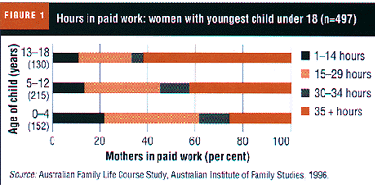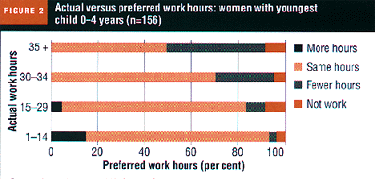Work and family values, preferences and practice
You are in an archived section of the AIFS website
September 1997
Download Research report
Overview
Initial findings from a new Institute study highlight the ways that parents' workforce participation is influenced by the values and preferences they hold for combining work and family life.
In the 1990s we are seeing rapid changes occurring in the nature, structure and organisation of work. People's decisions and choices about workforce participation and working hours are made in the context of social and economic opportunities and constraints. At a personal level this translates into the values and priorities people hold regarding their family life and their income earning requirements. Sometimes this results in compromises between actual and preferred working hours.
The private decisions people make about their working lives have implications for public policies related to the provision of income support and services such as child care and elder care.
The Australian Family Life Course Study, conducted by the Australian Institute of Family Studies in 1996, collected information from people in the workforce about their actual and preferred working hours, and from others not in the workforce about their work and family preferences.
Information was gathered from parents aged 25-50 years whose youngest child, in the age groups 0 - years, 5-12 years, and 13-18 years, lived with them in the household. The main focus of this analysis is on mothers with children aged up to 12 years.
Values
The shift from the traditional notion of men as sole breadwinners and women as caring for the children at home and doing the housework is illustrated in responses to the questions asked in the Institute's Australian Family Life Course Study about the values people hold.
Only one in four (23 per cent) of both men and women agreed with the statement: "A husband's job is to earn the money, a wife's is to look after the home and family".
Around two-thirds of men (65 per cent) and women (69 per cent) also agreed that: "Both partners should contribute to the household income".
When it came to the question asked of couples: "Who takes the main responsibility for being the economic provider?", six in ten men and women said that the male partner took more responsibility, three in ten couples agreed that such a responsibility was shared equally, and the remaining couples (just under one in ten) said that the woman was the main breadwinner.
Workforce participation
The age of youngest child clearly affects workforce participation rates for mothers, but is almost negligible for fathers.
According to the Australian Bureau of Statistics (ABS 1997), overall in Australia in 1997:
- 52 per cent of mothers in couple families and 34 per cent of sole mothers with their youngest child under the age five were in the workforce;
- by the time the youngest child is five to nine years of age, 72 per cent of mothers in couple families and 62 per cent of sole mothers were in paid work;
- by the time the youngest child is aged 10-14 years, 76 per cent of mothers in couple families and 61 per cent of sole mothers were in the workforce;
- for fathers in couple families, regardless of age of youngest child, 95 per cent were in the workforce.
Of mothers with children under the age of 18 years who participated in the Institute's Australian Family Life Course Study, two-thirds were in the paid workforce and one-third were not in paid work. In contrast, 91 per cent of fathers were employed.
Fathers' participation and preferences
Men's workforce participation and their preferences about working hours have historically been consistent with the fact that full-time work over the life course has been both the norm and the preferred option for men.
However, the economic climate in recent decades, combined with continuing industrial restructuring, has altered the employment opportunities and standard working hours for men.
Overall, 68 per cent of employee fathers and 70 per cent of self-employed fathers were working more than 41 hours per week. About 29 per cent of employees were working longer than 51 hours per week, but almost half (48 per cent) of the selfemployed worked these longer hours.
Not surprisingly, whether they were employees or self-employed, men who worked long hours desired to work standard working hours - generally considered to be around 40 hours a week.
Mothers' participation and preferences
Hakim (1997) argues that there is greater diversity in women's workforce preferences and patterns of participation than men's, which are more uniform. Given the increase in part-time employment, casual work and non-standard working hours, Hakim stresses the need to define what is actually meant by "part-time" work and suggests the following definitions of working hours:
- 'marginal jobs' - between 1-14 hours a week;
- 'half-time jobs' - between 15-29 hours a week;
- 'reduced full-time jobs' - between 30-34 hours a week;
- 'full-time jobs' - in Australia, defined as 35 or more hours per week.
These definitions are adopted throughout this analysis.
Mothers' hours in paid work
The Australian Family Life Course Study found a strong preference among women with dependent children for part-time work.

Figure 1 shows the number of hours mothers spend in paid work.
When the youngest child is 0-4 years old, 26 per cent of mothers are working full-time. A further 13 per cent could be considered to be working reduced full-time hours. Forty per cent of mothers work in half-time jobs, and 22 per cent are working marginal hours.
By the time the youngest child is 5-12 years old, 43 per cent of mothers are in full-time work. By the time the youngest child is 13-18 years, this increases to 62 per cent.
Mothers' actual hours versus preferred hours
Actual hours in paid work in relation to preferred working hours for women with children under 12 years is shown in Figures 2 and 3.

Figure 2 shows that when the youngest child is under five years, the majority of employed mothers prefer to be in part-time work.
Of mothers working marginal hours, 79 per cent wanted to work these hours and 15 per cent wanted to increase their hours. Three per cent wanted to work fewer hours, and 3 per cent did not want to be in paid work.
Of those working half-time, 79 per cent were happy with these hours, 5 per cent wanted to increase their hours, 8 per cent wanted to work fewer hours, and 8 per cent did not want to work at all.
Of mothers working reduced full-time hours of 30-34 hours, 70 per cent preferred to work these hours.
Of those who were working full-time, one-half preferred to work the same hours, 43 per cent wished for fewer hours, and 8 per cent did not want to be in the workforce.

Figure 3 shows the patterns for mothers whose youngest child was aged 5-12 years.
Of those in marginal jobs, 69 per cent were satisfied with their hours and 31 per cent would prefer to work additional hours.
Three-quarters of mothers working half-time were satisfied with those hours, 13 per cent wanted to increase their hours, 7 per cent wanted fewer hours, and 4 per cent did not want to be working.
For those working reduced full-time hours, 70 per cent were contented, 7 per cent wanted more hours, 19 per cent would prefer to work fewer hours, and 4 per cent preferred not working.
Among full-time workers, just over half prefer these hours, more than a third wanted to work fewer hours, 7 per cent would prefer to not be in paid work, and 2 per cent wanted to increase their hours.
The actual workforce activity and the work preferences of this group of mothers confirm the diversity of workforce participation patterns of women with dependent children. While the majority of working women were satisfied with their actual hours, most women working full-time would prefer to work fewer hours.
Preferences of mothers not in paid work
The perceptions of mothers whose youngest child is under 18 years and who are not currently in paid work are of relevance to this discussion of work and family. These are illustrated in Figure 4.

Forty-four per cent of this group of women prefer not being in paid work, particularly those whose youngest child is 0-4 years (53 per cent).
Irrespective of the age of their children, very few women (5 per cent) wanted full-time employment or reduced full-time employment (3 per cent).
However, four in ten mothers not in paid work would prefer to be in the workforce, but to be working half-time. According to Hakim (1997), the preferences of these women, therefore, would be for more than what is considered to be just marginal attachment to employment.
When women not in paid work were asked whether they intended to return to the workforce, 87 per cent with a child aged 0 4 years said they planned to return, as did 71 per cent with a child 5-12 years. However, currently only 13 per cent are actively seeking work.
It must be borne in mind that an expressed preference may not necessarily be translated into actual behaviour.
Family and social context
As demonstrated above, for women with family responsibilities, workforce participation and preference is likely to change according to family circumstances.
When we talk of preferences we touch on fundamental and entrenched attitudes and beliefs relating to a sense of identity, elements of self-esteem, and how rewards and contributions in personal, family and community domains are defined and perceived.
The salience and balance between the personal, family and social components of our lives are always changing and differ for men and women at different stages of the life cycle.
One indication of the intrinsic value of paid work versus other aspects of life was revealed in the responses of parents with children under 18 years to the question: "If you had a reasonable income without having to work, would you still prefer to have a paid job?". Seventy-two per cent of fathers and 64 per cent of mothers indicated that they would still prefer to work, thus indicating a strong degree of work attachment and the importance of employment to a sense of personal identity in both men and women.
These finding from the Institute's Australian Family Life Course Study illustrate the diversity among women with children in the choices they make to combine income earning with family responsibilities. The different ways families organise their work and family roles need to be recognised in the provision of services to families as well as in workplace negotiations and practice.
References
- Australian Bureau of Statistics (ABS) 1997, Labour Force Australia, April, Catalogue No. 6203.0.
- Hakim, C. (1997), Key Issues in Women's Work: Female Heterogeneity and the Polarisation of Women's Employment, Athlone, London.
About the study
The Australian Institute of Family Studies Australian Family Life Course Study conducted in 1996, is a random national telephone survey of just under 2,000 respondents aged between 25 and 50 years. Work and family issues across the life course was a major theme within the study.
Glezer, H., & Wolcott, I. (1997). Work and family values, preferences and practice (Australian Family Briefing No. 4). Melbourne: Australian Institute of Family Studies.
0 642 19539 0